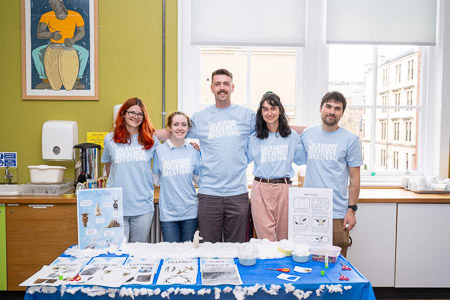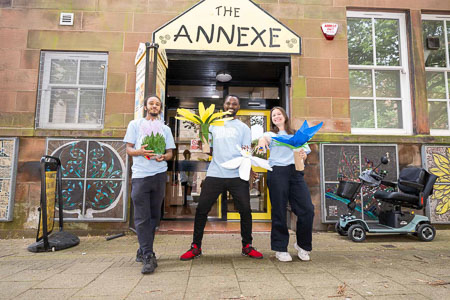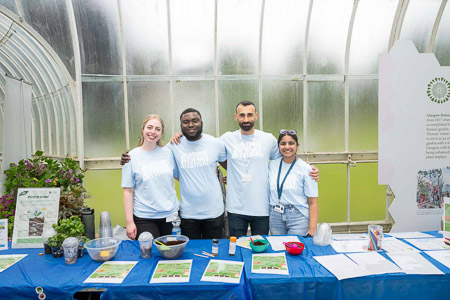Glasgow Science Festival in Action 2024
Glasgow Science Festival (GSF) 2024 ran from Thursday 6th to Sunday 16th June, with a packed programme of in-person events, under the theme ‘Glasgow’s Transforming’.
GSF in Action was delivered as a hybrid programme, with teaching and group work online then practice and delivery in-person. Five groups responded to the brief:
To support the GSF Coordinator and Director with the development of activities linked to this year’s festival theme ‘Glasgow’s Transforming. These will be delivered at either the Glasgow Botanic Gardens Family Day or the Partick Annexe Community Day.
Biomaterials: Healing Your Body with Jelly
The Biomaterials group created an activity to be delivered at the Glasgow Botanic Gardens. Their activity focused on showing how scientists are trying to heal severe injuries which cannot be healed naturally with gel. They used their activity to explore the fact that different tissues in the body behave very differently. For example, the brain is very soft, so a gel used to heal the brain would need to also be very soft. In contrast, bone is very hard and the gel used would need to be very stiff in order to repair a bone injury.
Activity:
Participants were tasked with creating a gel using the ingredients used to make the balls you see in bubble tea! Firstly, participants had to try create a ‘soft’ gel and repair a playdoh brain injury. Secondly, participants had to create a hard gel within a bone mould.
Thanks to Emily, Clara, Jack, Zarina and Finn for showcasing such exciting new research.
Animal Adaptation
The Animal Adaptation group created an activity to be delivered at the Partick Annexe Community Day. The inspiration for their activity was to show people how animals have adapted to live in different environments. These adaptations are required for animals to move, defend themselves and find food. In harsh environments like the ocean or the arctic, animals are in constant competition with each other for resources e.g. food, territory. Animals that develop helpful changes in their body can survive better and have offspring which can pass these adaptations down to the next generation.
Activity:
Participants were invited to create their own animal to adapt to either an arctic or ocean habitat. This was a craft-based activity where you could glue parts of animals together to create an animal adapted to one of the two environments. When participants had created an animal for each environment this allowed the group to discuss the differences between their creations with participants.
Group Photo
Thanks to Lucie, Antonia, Victoria, Isacco and Melissa for this creative activity.
Pollinator Playground
The Pollinator playground group created a set of activities which were designed to be delivered at the Partick Annexe Community Day. Their activities explored how adaptations between different butterflies allows them to access the pollen from different flowers. Some butterflies have really long tongues which allows them to access the pollen deep inside flowers, but others have short tongues so they can’t reach!
Activity 1:
The first activity they designed was to create a butterfly headband that was either a painted lady, large blue or peacock butterfly.
Activity 2:
Participants, wearing their butterfly headbands, had to ‘fly’ around the room and collect pollen from parks. The group had crafted giant flowers which had different colours of pollen beads. A participant could only collect the pollen from the flower if it held the right colour bead for their butterfly, demonstrating that different butterflies have different adaptations enabling pollen collection from different flowers.
Activity 3:
Participants were invited to create a butterfly ring made entirely out of pipe cleaners. Participants were invited to be creative with the colours they chose.
Group Photo
Thanks to Connor, Olivia, Victoria, Li An and Joseph for a very thoughtful set of activities.
Park in a Cup: Be Your Own Ecosystem Engineer
This group were tasked to create an activity to be delivered at the Glasgow Botanic Gardens. They were inspired to create an activity to describe a park ecosystem. An ecosystem is a community of animals, plants, and tiny organisms living together with their surroundings. If one-part changes, it affects everything else.
Activity:
Their activity consisted of building your own terrarium in a cup. Participants added each component required for a terrarium – rocks which were clay balls, soil, planted some seeds, and finally participants could create their own bug stickers to decorate the terrarium. Participants were given a take home care guide to looking after their terrarium to take home.
Group Photo
Thanks to Julia, Oscar, Maisha and Yusuf for a very creative and educational activity.
Detective Knutsford and the Missing Red Squirrels
This group created a set of activities to be delivered at the Glasgow Botanic Gardens surrounding the decline of red squirrels in the UK. The estimated number of grey squirrels in UK is ~2.7 million but the number of red squirrels is now only 120,000. The main reason for the decline of red squirrels is the competition with the non-native grey squirrels which were first introduced from North America in the late 1800s to decorate gardens of Victorian homes.
Activity 1: Scavenger hunt
The first activity was a scavenger hunt for red squirrels around the Kibble Palace. Each participant had a sheet with questions and the squirrels held the answers. The questions and answers were all reasons why red squirrels are declining.
An example question is:
What sickness hurts the red squirrels but not the grey squirrels?
Answer: Squirrel pox
Activity 2:
The second activity was a craft activity where participants were tasked with creating their own red squirrel out of paper.
Activity 3:
The final activity was a bookmark craft activity where participants could create their own red squirrel bookmark.
Group Photo
Thanks to Paula, Lineta, Chantal and Elaine for a really fun set of activities.


